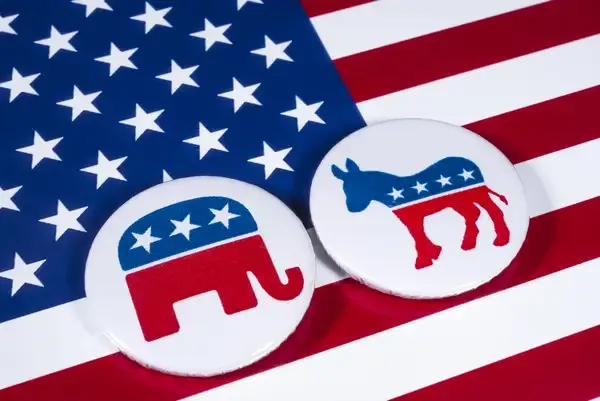
Source: Chris Dorney/Dreamstime.com
The two-party system in the United States is a political system where two main political parties dominate elections and government decisions. These two parties are the Democratic Party and the Republican Party. While other smaller parties exist, they rarely win major elections because the two big parties have more support and power.
The Democratic Party is symbolized by a donkey, which dates back to 1828 when candidate Andrew Jackson embraced the image after being called a jackass
(another word for donkey). The Republican Party is represented by an elephant, a symbol popularized by a political cartoon in 1874, showing the animal as strong and powerful. These symbols have since become iconic representations of the two parties.
One of the main concepts of the two-party system is that it simplifies choices for voters. Instead of many different parties, people usually choose between two main options. Another important idea is that it creates stability. Since only two parties have real power, it is easier for the government to make decisions without being blocked by many different groups.
There are advantages to this system. First, it makes it easier for voters to understand the differences between the two main parties, as they generally represent opposite ideas. Second, it encourages moderation, because both parties want to appeal to a wide range of voters to win elections.
However, there are also disadvantages. One is that the system can make it hard for smaller parties to grow, even if they have good ideas. Another is that it sometimes limits the choices voters have. If someone doesn’t agree with either of the two main parties, it can feel like their vote doesn’t count as much.
In summary, the two-party system is a central part of U.S. politics, with both benefits and challenges. It simplifies voting and brings stability, but can limit new ideas and lead to political division.
The two-party system in the United States is a political system where two main political parties dominate elections and government decisions. These two parties are the Democratic Party and the Republican Party. While other smaller parties exist, they rarely win major elections because the two big parties have more support and power.
The Democratic Party is symbolized by a donkey, which dates back to 1828 when candidate Andrew Jackson embraced the image after being called a jackass
(another word for donkey). The Republican Party is represented by an elephant, a symbol popularized by a political cartoon in 1874, showing the animal as strong and powerful. These symbols have since become iconic representations of the two parties.
One of the main concepts of the two-party system is that it simplifies choices for voters. Instead of many different parties, people usually choose between two main options. Another important idea is that it creates stability. Since only two parties have real power, it is easier for the government to make decisions without being blocked by many different groups.
There are advantages to this system. First, it makes it easier for voters to understand the differences between the two main parties, as they generally represent opposite ideas. Second, it encourages moderation, because both parties want to appeal to a wide range of voters to win elections.
However, there are also disadvantages. One is that the system can make it hard for smaller parties to grow, even if they have good ideas. Another is that it sometimes limits the choices voters have. If someone doesn’t agree with either of the two main parties, it can feel like their vote doesn’t count as much.
In summary, the two-party system is a central part of U.S. politics, with both benefits and challenges. It simplifies voting and brings stability, but can limit new ideas and lead to political division.
1
2
3
4
5
6
7
8
9
10
11
12
13
14
15
16
17
18
19
20
21
22
23
24
25
Word bank:
Two-party system - Zwei-Parteien-System; to dominate - dominieren; government - Regierung;
to simplify - vereinfachen; moderation - Mäßigung; to appeal - ansprechen; advantage - Vorteil;
disadvantage - Nachteil; political division - politische Spaltung; to embrace - übernehmen
https://www.tutory.de/entdecken/dokument/the-two-party-system-in-the-united-states



